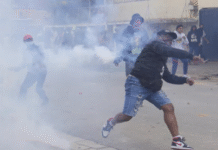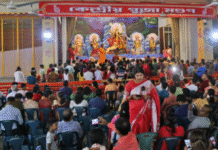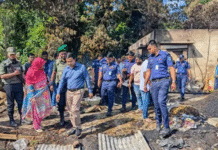Huddled at different shelters in Rangamati, with inadequate food, water, medicine and other amenities, landslide-affected people find it hard to imagine what the coming days would be like for them, with their homesteads buried deep into mud.
Some 2,900 affected people from 643 families are currently living in 19 shelters, opened by the Rangamati district administration since the catastrophe struck the region on June 13.
Downpour over the past few days has driven more people to join them every day only to add to the sufferings of people already crammed in the shelters.
The district administration is still using loud speakers to warn the people against fresh landslide, urging them to move to safer places as the rain continued to pour in.
Those who are moving to the shelters have found an unhygienic situation that left many elderly and children affected with water-borne diseases, including diarrhea.
At a shelter opened at Bangladesh Open University, around 300 people are living in four rooms with three corridors and only two toilets available for them to use.
The situation is no different in Television Sub-centre, where around 500 people are living in a congested condition.
At Shishu Academy centre, however, only twelve families were found on Wednesday.
Somota Begum, one of the survivors, said that they were passing days in inhuman condition, but could not go back home as they were fully damaged.
Ayesha Khatun and Momota Begum at Shishu Academy centre echoed Somota.
‘Winds blew away the roof of my house… I could not go back home,’ said Ayesha.
She said the government was only providing meals twice a day here while safe water, iftar and medicines were inadequate too.
Rashida Begum, at Shahid Abdul Ali High School, said she got relief materials, cash money or corrugated iron sheets to rebuild her home.
Many landslides victims said their houses were beyond reconstruction.
‘My house went under 30-feet mud. Now it is not possible to rebuild a house at the same place,’ Unuching Marma, who was from village Bidyanagar, said at Roads and Highways colony.
Rangamati deputy commissioner Manjarul Mannan, however, said the government had enough stock of food and other relief materials to feed the affected people.
He said that as of Tuesday they provided 30kg rice for each of the 2,100 affected families, including 1,100 in the Rangamati town.
In addition, the district administration has allotted 2oogm rice and Tk 40 for each people living in the shelters.
District administration, so far, has distributed around Tk 48 lakh with 206 tonnes of rice, he said.
Among the 19 shelters, Bangladesh Army is managing seven while police, Border Guard Bangladesh and Red Crescent Society four each respectively under the supervision of an executive magistrate at each place.
Some 95 makeshift toilets were constructed at different shelters to ensure hygiene and sufficient oral saline
were provided at shelter centres, he claimed.
Shah Kamal, secretary of the ministry of disaster management of relief, earlier on Tuesday told New Age that government decided to keep the shelters open until July 15.
The landslides caused by downpour in Rangamati, Chittagong, Bandarban, Khagrachari, Cox’s Bazar and Moulvibazar killed at least 166 people between June 12 to June 18.
Ranagamati was the worst affected as the highest 118 people died in the district by the catastrophe.
The government has formed a 21-member committee under an additional secretary of the ministry to determine the extent of the damage caused by the landslide. The committee was given 30 days to submit their report.
Source: New Age









